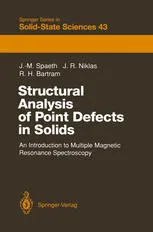Structural Analysis of Point Defects in Solids: An Introduction to Multiple Magnetic Resonance Spectroscopy
4.5
Reviews from our users

You Can Ask your questions from this book's AI after Login
Each download or ask from book AI costs 2 points. To earn more free points, please visit the Points Guide Page and complete some valuable actions.Introduction
Welcome to "Structural Analysis of Point Defects in Solids: An Introduction to Multiple Magnetic Resonance Spectroscopy," a cornerstone text that delves deeply into the intricate world of point defects in solid materials. Authored by Professor Dr. Johann-Martin Spaeth, Priv.-Doz. Dr. Jürgen R. Niklas, and Professor Ralph H. Bartram, this book offers a comprehensive exploration of how multiple magnetic resonance techniques can be harnessed to investigate the structural, electronic, and dynamical properties of point defects.
Point defects in solids play a critical role in determining the physical, chemical, and electronic properties of materials. These imperfections, though minute, significantly impact various applications, ranging from semiconductors to optoelectronics and quantum technologies. This book is a meticulously crafted guide for scientists and researchers who want to uncover the structural intricacies of point defects using magnetic resonance spectroscopy.
Structured with precision and clarity, this text introduces the reader to the theoretical framework, experimental methodologies, and practical applications of Electron Paramagnetic Resonance (EPR), Electron-Nuclear Double Resonance (ENDOR), and related techniques. Targeting both seasoned researchers and those new to the field, the book offers carefully curated examples and case studies to contextualize this powerful approach within a broad spectrum of scientific investigations.
Detailed Summary of the Book
"Structural Analysis of Point Defects in Solids" is divided into key chapters that build on one another, forming a cohesive narrative around magnetic resonance techniques and their application to point defect analysis. The book begins by introducing fundamental concepts such as the nature of point defects and the basic principles of magnetic resonance spectroscopy. It then delves deeper into advanced methodologies, including:
- Electron Paramagnetic Resonance (EPR) for studying unpaired electron systems.
- Electron-Nuclear Double Resonance (ENDOR) to probe interactions at the atomic scale.
- Other advanced techniques like high-field EPR and pulsed techniques.
Each chapter is carefully structured, providing historical context, theoretical grounding, and practical examples. Detailed discussions on computational techniques, simulation methods, and the integration of spectroscopic data into defect models make this book an invaluable resource for understanding the structural properties of defects.
The book is particularly unique in addressing multiple spectroscopic techniques comprehensively, allowing the reader to compare and integrate results across methods. From localized defect states in ionic crystals to defect behavior in technologically relevant materials like semiconductors, the case studies are chosen strategically to represent real-world applications.
Key Takeaways
- Gain an in-depth understanding of point defects and their role in the properties of solids.
- Learn how multiple magnetic resonance techniques, especially EPR and ENDOR, can unravel defect structures at atomic levels.
- Acquire practical knowledge of interpreting spectroscopic data and integrating it into computational defect models.
- Understand the broad applicability of these techniques in modern technologies, including semiconductors, laser materials, and quantum devices.
- Find detailed explanations of the synergies between theoretical modeling and experimental approaches.
By reading this book, researchers and students will be equipped with the tools necessary to engage in cutting-edge material science research and push the boundaries of what we know about defects in solids.
Famous Quotes from the Book
"Point defects are not mere imperfections; they are nature's subtle fingerprints on the canvas of solid-state materials."
"The versatility of magnetic resonance techniques lies in their ability to probe the unseen, revealing the symmetries and asymmetries of matter on an atomic level."
"Understanding point defects is not merely an academic exercise; it is a gateway to designing next-generation technologies."
Why This Book Matters
Point defects are the bridge between fundamental material properties and their practical applications in advanced technologies. Yet, their study requires sophisticated techniques and interpretative frameworks, which this book masterfully provides. By marrying theory with practice, "Structural Analysis of Point Defects in Solids" equips researchers with the tools and knowledge needed to address critical questions in materials science.
In an era where quantum computing, renewable energy, and advanced semiconductors dominate technological advancements, understanding defects at the atomic level is of paramount importance. This book not only demystifies the structural analysis of point defects but also inspires the reader to utilize magnetic resonance spectroscopy for broader, interdisciplinary applications.
Students, experts, and engineers alike will find this book indispensable. It challenges conventional thinking, introduces innovative methodologies, and provides an authoritative reference on a pivotal subject. This is not just a book; it is a gateway to exploring and advancing the frontiers of material sciences.
Free Direct Download
You Can Download this book after Login
Accessing books through legal platforms and public libraries not only supports the rights of authors and publishers but also contributes to the sustainability of reading culture. Before downloading, please take a moment to consider these options.
Find this book on other platforms:
WorldCat helps you find books in libraries worldwide.
See ratings, reviews, and discussions on Goodreads.
Find and buy rare or used books on AbeBooks.
1131
بازدید4.5
امتیاز50
نظر98%
رضایتReviews:
4.5
Based on 0 users review
"کیفیت چاپ عالی بود، خیلی راضیام"


